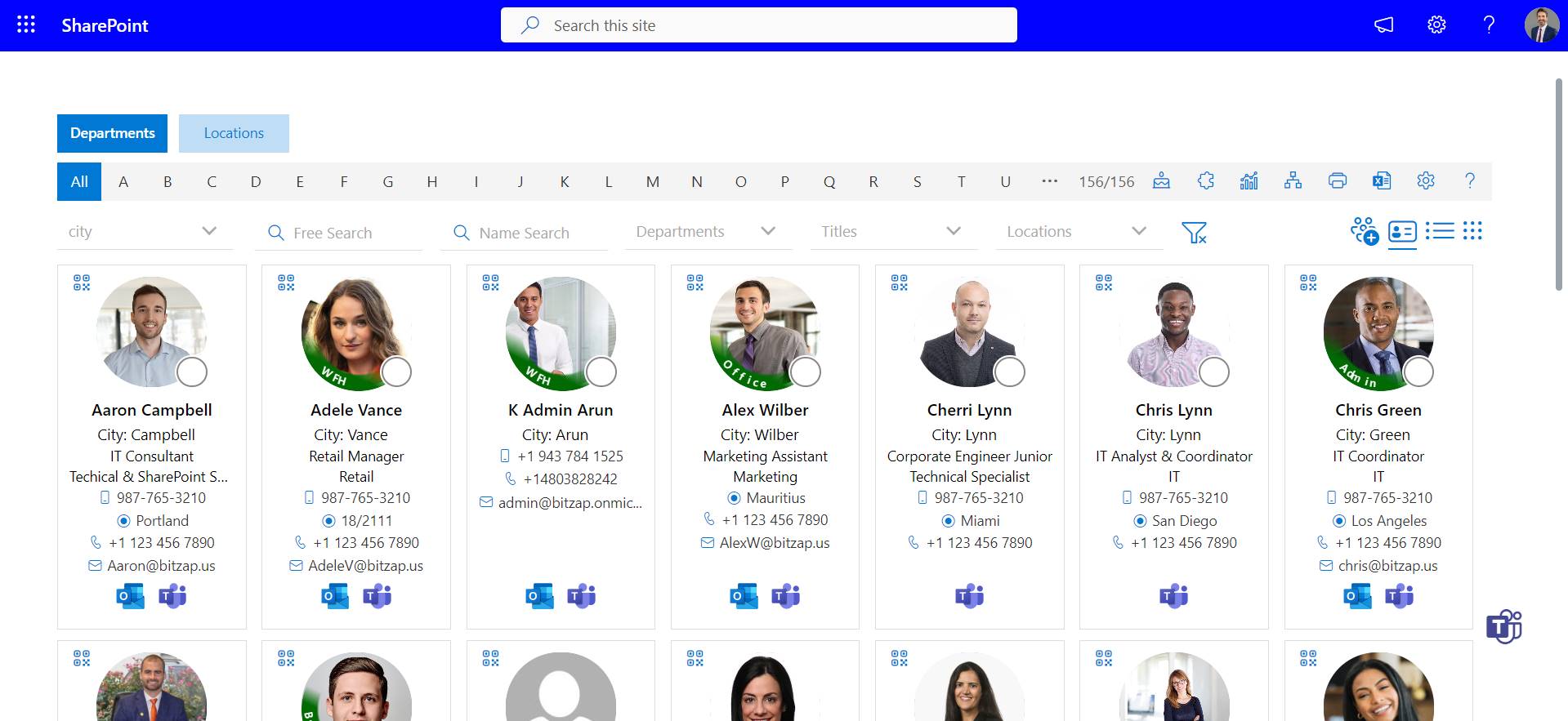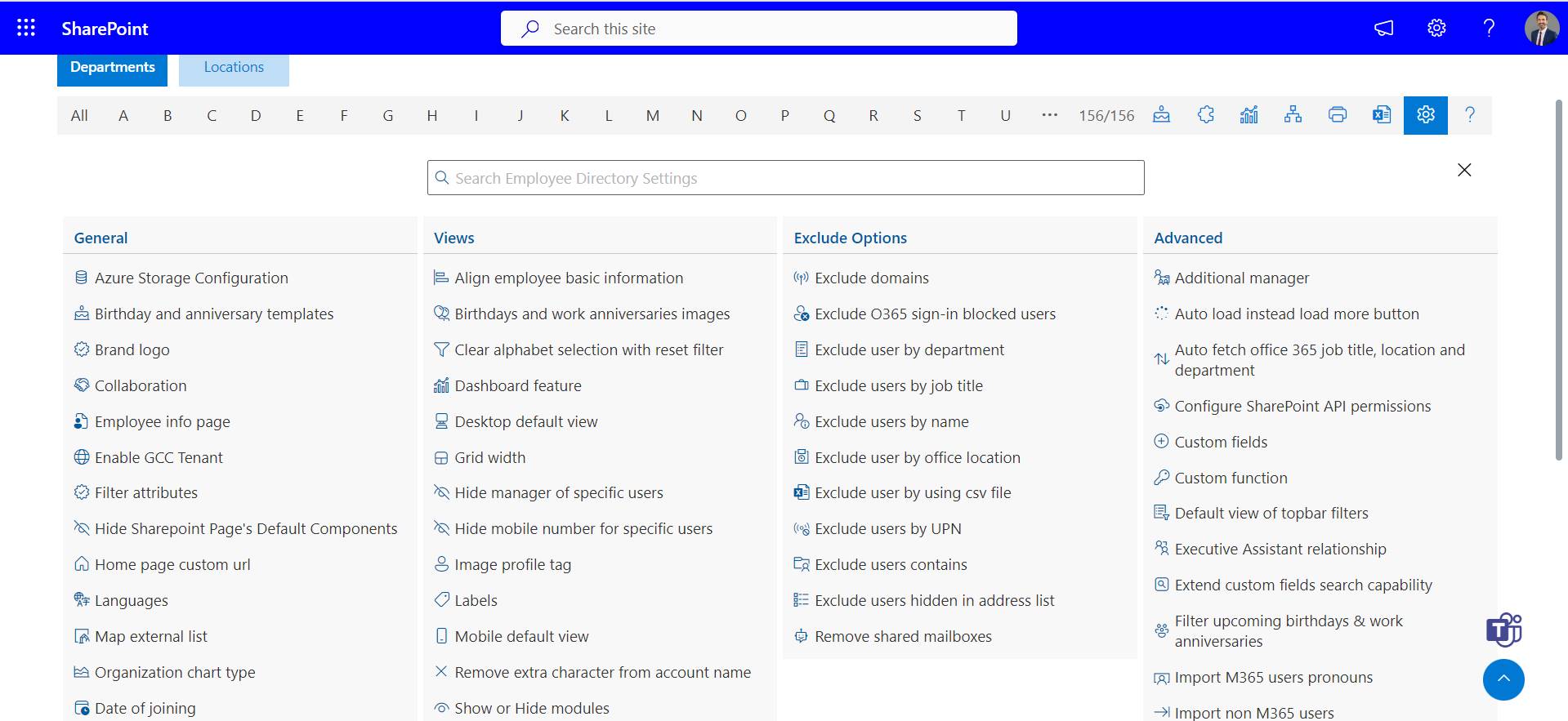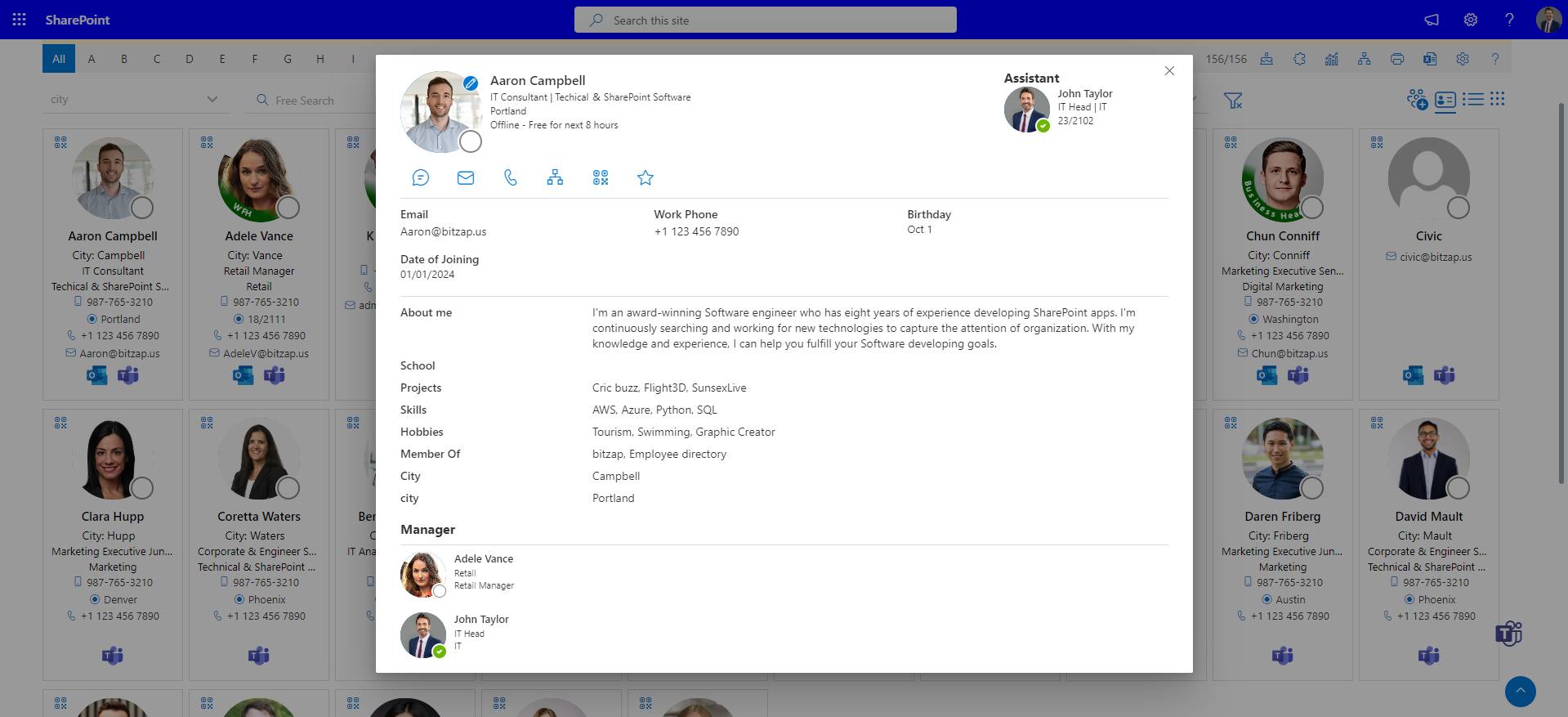Top 10 Employee Directory Software Solutions
With so many options available, choosing the best employee directory software is critical for increasing organizational efficiency. In this blog, we’ll explore the top 10 employee directory software solutions, highlighting their key features, benefits, and suitability for diverse business needs.
Top 10 Employee Directory Software Solutions
Here are the top 10 employee directory software that is suitable for your diverse business needs.
- BambooHR: BambooHR is a comprehensive HR software that includes an intuitive employee directory feature. It offers a centralized platform for managing employee information, including contact details, job roles, performance evaluations, and more. With customizable fields and robust search capabilities, BambooHR enables seamless access to critical employee data, promoting transparency and efficiency in HR operations.
- Microsoft Active Directory: Microsoft Active Directory is a widely used directory service that provides centralized management of network resources, including user accounts, computers, and applications. With its LDAP-based architecture, Active Directory offers authentication, authorization, and access control capabilities, making it ideal for large enterprises seeking a scalable and secure employee directory solution.
- Employee Directory 365: Employee Directory 365 stands out as one of the premier employee directory software solutions, offering a comprehensive suite of features designed to streamline workforce management within the Microsoft 365 ecosystem. Built on top of Microsoft’s powerful cloud infrastructure, Employee Directory 365 seamlessly integrates with familiar tools such as Outlook, SharePoint, and Teams, providing users with a unified platform for accessing and managing employee information.
- Zenefits: Zenefits is an all-in-one HR platform that includes an employee directory module among its suite of features. It allows organizations to manage employee information, benefits, payroll, and compliance in one integrated system. With its user-friendly interface and mobile app accessibility, Zenefits empowers HR professionals and employees alike to access and update relevant information anytime, anywhere.
- Workday: Workday offers a cloud-based HR and finance system that includes robust employee directory functionality. Its unified platform enables organizations to manage workforce data, organizational hierarchies, and talent profiles effectively. With advanced reporting and analytics capabilities, Workday provides actionable insights for strategic workforce planning and decision-making.
- Pingboard: Pingboard is a modern employee directory software designed to enhance organizational transparency and communication. Its visually appealing org chart interface provides a dynamic view of team structures and relationships, enabling employees to discover and connect with colleagues easily. With features such as employee profiles, birthday reminders, and integration with popular communication tools, Pingboard fosters a vibrant company culture.
- ADP Workforce Now: ADP Workforce Now is a comprehensive HR and payroll solution that includes employee directory features for managing workforce information. It offers customizable employee profiles, organizational charts, and reporting capabilities to meet the diverse needs of midsize and large businesses. With its mobile app and self-service options, ADP Workforce Now empowers employees to update their information and access HR services independently.
- OrgChart Now: OrgChart Now is a specialized org chart software that helps organizations visualize their workforce structures and hierarchies. With its drag-and-drop interface and automatic data synchronization, OrgChart Now simplifies the creation and maintenance of dynamic org charts. It integrates with HR systems and databases to ensure data accuracy and reliability, making it a valuable tool for organizational planning and decision-making.
- People HR: People HR is a cloud-based HR software that includes employee directory features for managing personnel information and organizational structures. It offers customizable fields, role-based access controls, and GDPR compliance functionalities to meet data privacy requirements. With its self-service portal and mobile app, People HR empowers employees to update their profiles, request time off, and access HR resources effortlessly.
- Oracle HCM Cloud: Oracle HCM Cloud is a comprehensive human capital management solution that includes employee directory capabilities as part of its suite of HR modules. It provides a unified platform for managing employee data, talent acquisition, performance management, and workforce planning. With its built-in analytics and AI-driven insights, Oracle HCM Cloud enables organizations to optimize their HR processes and drive business growth.
Advantages of using the best Employee Directory Software
Using the best Employee Directory Software offers numerous advantages for organizations of all sizes. Here are some key benefits:
Centralized Employee Information:
All employee information into a single, easily accessible platform. This includes staff contact lists, job roles, departmental affiliations, skills, certifications, and more. Having a centralized repository eliminates the need to maintain multiple spreadsheets or databases, ensuring data consistency and accuracy.
Improved Communication:
With the software, employees can quickly find and contact their colleagues, facilitating seamless communication within the organization. Whether it’s sending an email, scheduling a meeting, or initiating a chat conversation, having access to up-to-date contact information streamlines communication channels and reduces response times.
Enhanced Collaboration:
By providing insights into employees’ expertise and roles within the organization, Employee Directory Software promotes cross-functional collaboration and knowledge sharing. Teams can easily identify subject matter experts, assemble project teams, and leverage diverse skill sets to achieve common goals more efficiently.
Efficient Onboarding:
Employee Directory Software simplifies the onboarding process for new hires by providing them with access to essential employee information from day one. New employees can quickly familiarize themselves with their colleagues, understand reporting structures, and establish professional connections, accelerating their integration into the organization.
Transparency and Accountability:
With features such as org charts and team structures, Employee Directory Software enhances organizational transparency by illustrating reporting relationships and hierarchies. This promotes accountability and clarity in roles and responsibilities, reducing ambiguity and fostering a culture of accountability.
Empowerment and Engagement:
Employee Directory Software empowers employees by giving them greater visibility into the organization’s structure and resources. Employees feel more connected and engaged when they can easily find and connect with their colleagues, access relevant information, and participate in cross-departmental initiatives.
Data Security and Compliance:
Leading Employee Directory Software solutions prioritize data security and compliance, implementing robust access controls, encryption protocols, and compliance measures to protect sensitive employee databases. This ensures adherence to data protection regulations such as GDPR and CCPA, mitigating the risk of data breaches and unauthorized access.
Strategic Decision-Making:
Employee Directory Software provides valuable insights into workforce demographics, skills gaps, and talent distribution, empowering leaders to make informed decisions regarding resource allocation, talent management, and organizational development initiatives. By leveraging data-driven insights, organizations can optimize their workforce strategies and drive business growth.
Challenges of using the Employee Directory
Implementing and utilizing an employee directory can be highly beneficial, but it’s not without its challenges. Here are some common obstacles organizations face when using an employee directory:
- Data Accuracy and Integrity: Maintaining accurate and up-to-date employee information can be challenging, especially in large organizations with frequent personnel changes.
- User Adoption: Encouraging employees to actively use and engage with the employee directory can be a hurdle. Resistance to change or reluctance to input personal information may hinder user adoption.
- Privacy Concerns: Employees may have concerns about the privacy and security of their personal information stored in the directory. Addressing these concerns by implementing robust data protection measures, such as access controls and encryption, is essential to instill confidence in the system.
- Integration with Existing Systems: Integrating the employee directory with other existing systems, such as HRIS, email clients, and collaboration platforms, can be complex.
- User Experience: The user interface and experience of the employee directory software can significantly impact its usability and effectiveness. If the interface is unintuitive or difficult to navigate, employees may struggle to find the information they need, leading to frustration and reduced adoption rates.
- Cultural and Organizational Barriers: Organizational culture and dynamics can also pose challenges to the successful implementation of an employee directory. Resistance from certain departments or individuals, political dynamics, or hierarchical structures may impede collaboration and hinder the directory’s effectiveness.
- Maintenance and Updates: Employee directories require ongoing maintenance, updates, and technical support to remain functional and effective. Regularly updating employee information, addressing technical issues, and incorporating user feedback are essential for ensuring the directory’s relevance and usability over time.
- Scalability: As organizations grow or undergo changes, scalability becomes a concern. Ensuring that the employee directory can scale to accommodate an expanding workforce, new departments, or organizational restructuring requires careful planning and scalability features built into the software.
- Cost and Resource Allocation: Implementing and maintaining an employee directory software solution involves financial investment and resource allocation. Balancing the costs associated with software licenses, infrastructure, training, and support against the expected benefits and ROI can be a challenge for organizations, particularly those with budget constraints.
Conclusion:
Selecting the right employee directory software is essential for optimizing workforce management, fostering collaboration, and enhancing organizational efficiency. Whether you’re a small business looking for a user-friendly solution or a large enterprise requiring scalability and advanced features, the top 10 employee directory software solutions mentioned above offer diverse options to meet your specific needs. Evaluate each solution based on your organizational requirements, budget, and long-term strategic goals to make an informed decision that drives success in the digital workplace.
Frequently Asked Questions
An employee directory application is a software tool or platform designed to centralize and manage information about employees within an organization.
It provides a convenient and accessible way for employees to search for and find contact information, organizational hierarchies, and other relevant details about their colleagues.
Employee directory applications typically include features such as search functionality, employee profiles, contact information, organizational charts, and sometimes additional capabilities like integration with other systems or advanced search filters.
These applications can be web-based, mobile-friendly, or integrated into existing intranet or communication platforms, offering flexibility in how employees’ access and interact with the directory.
Creating an employee directory involves several steps, and the specific process may vary depending on your organization’s needs and the tools available.
Here’s a general guide to help you create an employee directory:
- Gather Employee Information: Collect relevant information about your employees, including names, contact details (email addresses, phone numbers), job titles, departments, reporting structures, and any other relevant details you want to include in the directory.
- Design the Directory Structure: Determine how you want to organize and structure the directory. Consider categorizing employees by department, job title, or any other relevant criteria. Decide which fields you’ll include in the directory and how you’ll display the information.
- Input Employee Data: Enter the employee information you gathered into the chosen platform or tool. If using a spreadsheet, create columns for each data field (e.g., name, email, department) and enter the information accordingly. If using software, follow the provided instructions for adding employee profiles.
- Customize and Format: Customize the appearance and format of the directory to meet your organization’s branding and design preferences. Add headers, labels, or color schemes to make the directory visually appealing and easy to navigate.
- Review and Update: Review the directory to ensure that all employee information is accurate and up to date. Regularly update the directory as employees join, leave, or change roles within the organization.
- Share the Directory: Determine how you’ll share the employee directory with employees. You could distribute it via email, share it on your organization’s intranet or internal portal, or provide access through dedicated directory software. Ensure that employees know how to access and use the directory effectively.
By following these steps, you can create an employee directory that meets the needs of your organization and helps employees connect and collaborate more effectively.
Choosing the right employee directory software for your organization requires careful consideration of several factors to ensure that the solution aligns with your specific needs and objectives. Here’s a step-by-step guide to help you make an informed decision:
Identify your requirements: Start by identifying the key requirements and objectives for implementing employee directory software in your organization. Consider factors such as the size of your organization, the complexity of your organizational structure, the need for integration with other systems, and any specific features or functionalities you require.
Evaluate features: Research and evaluate employee directory software solutions based on their features and capabilities. Look for features such as customizable employee profiles, search functionality, organizational chart visualization, mobile access, employee self-service capabilities, and integration with other systems such as HRIS or collaboration tools.
Consider scalability: Choose a solution that can scale with your organization’s growth and evolving needs. Consider factors such as the number of employees the software can support, the ability to add new features or modules as needed, and the scalability of the pricing model.
Assess ease of use: Select employee directory software that is intuitive and user-friendly for both administrators and employees. Consider factors such as ease of navigation, clarity of user interface, and availability of training and support resources to help users get up to speed quickly.
Check integration capabilities: Ensure that the employee directory software can seamlessly integrate with other systems and tools used within your organization, such as HRIS, email clients, calendar applications, and collaboration platforms. Integration capabilities ensure smooth data exchange and workflow automation across different systems.
Review security and compliance: Prioritize security and compliance features to protect sensitive employee information and ensure compliance with relevant regulations such as GDPR or CCPA. Look for features such as role-based access controls, data encryption, audit trails, and compliance with industry standards for data privacy and security.
Evaluate vendor reputation and support: Research the reputation and track record of potential software vendors or providers. Look for customer reviews, testimonials, case studies, and references from organizations similar to yours. Consider factors such as vendor reliability, responsiveness to support inquiries, ongoing maintenance and updates, and the availability of user communities or forums for knowledge sharing.
Assess cost and ROI: Consider the cost of implementing and maintaining the employee directory software, including licensing fees, implementation costs, ongoing support and maintenance fees, and any additional costs for customization or integration. Evaluate the potential return on investment (ROI) based on the expected benefits such as improved communication, productivity gains, and reduced administrative burden.
By following these steps and carefully evaluating your options, you can choose the right employee directory software that meets your organization’s needs and helps you achieve your objectives effectively.
Employee directory software can be secure if designed and implemented with appropriate security measures to protect sensitive employee information. Here are some key security considerations for employee directory software:
Data Encryption: Employee directory software should encrypt sensitive data both in transit and at rest to prevent unauthorized access or interception. Encryption ensures that even if data is intercepted, it remains unreadable without the appropriate decryption key.
Access Controls: Implement role-based access controls (RBAC) to restrict access to employee information based on user roles and permissions. This ensures that only authorized users have access to sensitive data, and access rights are granted on a need-to-know basis.
User Authentication: Require strong authentication mechanisms, such as passwords, multi-factor authentication (MFA), or single sign-on (SSO), to verify the identity of users accessing the employee directory software. This helps prevent unauthorized access by ensuring that only authenticated users can log in.
Audit Trails: Maintain detailed audit trails that track user activities within the employee directory software, including logins, access attempts, modifications to employee records, and other relevant actions. Audit trails help organizations monitor user behavior, detect suspicious activities, and investigate security incidents.
Data Masking: Employ data masking techniques to conceal sensitive information, such as social security numbers, salary details, or personal contact information, from unauthorized users. Data masking ensures that only users with appropriate privileges can view sensitive data, while protecting employee privacy.
Secure Transmission: Ensure that employee directory software uses secure communication protocols, such as HTTPS, to encrypt data transmitted between users’ devices and the software servers. Secure transmission prevents data interception or tampering during transit over untrusted networks.
Regular Security Updates: Keep the employee directory software up-to-date with the latest security patches, updates, and bug fixes to address vulnerabilities and mitigate security risks. Regularly updating the software helps protect against known security threats and ensures that security measures remain effective over time.
Compliance with Regulations: Ensure that the employee directory software complies with relevant data protection regulations, such as GDPR, CCPA, HIPAA, or other industry-specific requirements. Compliance with regulations helps organizations maintain data privacy, protect employee rights, and avoid potential legal or regulatory consequences.
By implementing these security measures, employee directory software can provide a secure environment for managing and accessing employee information, protecting sensitive data from unauthorized access, and maintaining confidentiality, integrity, and availability.
Schedule a free personalized 1:1 demo
By proceeding, you accept Cubic Logics’s terms and conditions and privacy policy






Start Your Free Experience
By proceeding, you accept Cubic Logics’s terms and conditions and privacy policy






Schedule a free personalized 1:1 demo
By proceeding, you accept Cubic Logics’s terms and conditions and privacy policy






Try It Free, No Obligation
By proceeding, you accept Cubic Logics’s terms and conditions and privacy policy






Request of the Free License
By proceeding, you accept Cubic Logics Terms and Conditions and Privacy Policy
Offer is expiring soon!
Fill in your details below to receive your personalized coupon code.
Start Your Free Experience
By proceeding, you accept Cubic Logics’s terms and conditions and privacy policy











